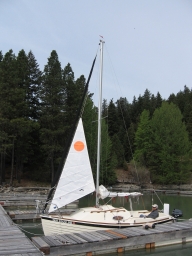New Bow Plate and Solent Stay For Storm Jib Total Page Hits: 3486
Post Type: Technical/Project
Boat Part: Not Specified
Date Modified: 11/27/2016 12:16 PM
About every day on our lake the wind varies from 5 to 30 + mph. 20 to 30 + wind this is not our preferred sailing condition, but on our mountain like our lake that’s what we get. Our original headsail was the popular Elliot Pattison 135, with luff foam, on a CDI roller. This sail was said to perform well through a wide range of wind. After one season sailing in 20 – 30+ mph winds with a roller reefed 135, it was clear that roller reefing would not accommodate our range of wind. We found that when we rolled past 15% the 135 got wrinkles, lost good sail shape, flogged a lot and put too much stress on the CDI. After much reading we got interested in adding a storm jib and a solent stay; however, two prominent small boat sail makers suggested we try a 109, with foam. We bought the 109, tried it and found the same problems as the 135. So we decided to add a solent stay.
We started by adding a new bowplate. Our new bowplate would be positioned the same as on Jerrys’ M17s through model year 2001. In model year 2002 the bow plate was relocated about 5.25” back onto the deck. We preferred the forward location in every way. So we removed the bowlight and measured carefully for a new bowplate. We had it manufactured from 316 ss, by a local metal shop and shipped to Portland for passivation. Given that Yakima is a small city, we believe most cities will have a metal shop with this capability. We also gave our CADD drawing to Sage marine, hoping in their next run of Sage bowplates they would make a few of these for other post 2002 M17 owners.
The attached photo and captions show the rest of the added rigging.
We have two seasons, about 30 of 50 days, sailing with this rig. Often we switch from our roller with 109 to our solent with storm jib as the day, and wind, progress. Sail changes are not too difficult with a two person crew; definitely not a change for single handing. The storm jib performs far better than a roller reefed headsail. It does not seem to mind the turbulence caused by the rolled headsail, 5” ahead of it; but in 30+mph wind who could notice a little turbulence. This is our first boat with a solent stay and a storm jib. This is an arrangement that could be used on just about any sailboat. It is puzzling why so few sailors know about solent stays. Many days, with our solent stay, we own the lake; the other sailboats just can’t take the wind and motor back to docks.









